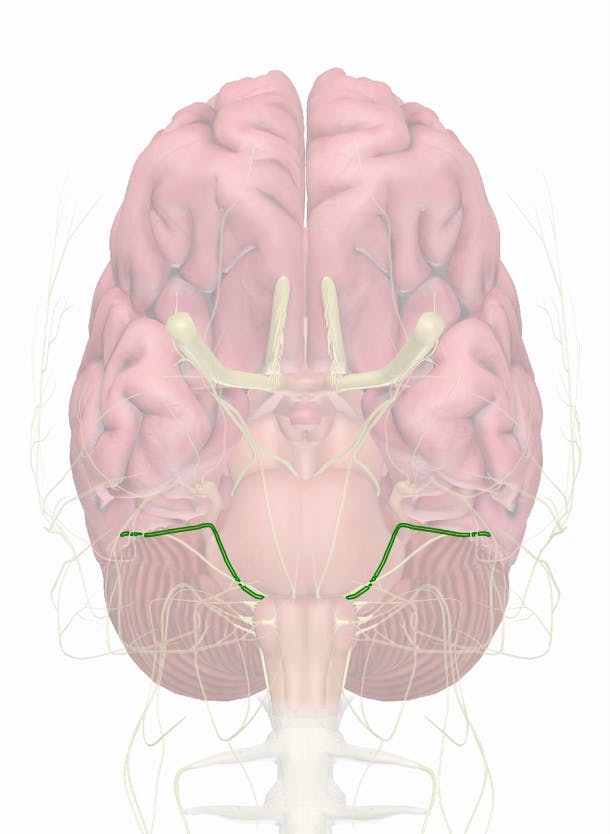Cranial nerve VIII, the vestibulocochlear nerve, is one of 12 major cranial nerves in the head. It plays a vital role in the body’s senses of hearing and equilibrium by carrying information between the inner ear and the brain. The vestibulocochlear nerve was previously known as the auditory nerve or the acoustic nerve, but its name was changed to include its crucial role in the vestibular system.
Anatomy
The 8th cranial nerve, also known as cranial nerve VIII, CN VIII, or the vestibulocochlear nerve, is a paired nerve (i.e., one on the left and right sides of the body) that carries nerve signals between the vestibule and cochlea of the inner ears and the brain. Counting from the anterior end of the brain, it is the eighth cranial nerve to enter the brain. The vestibulocochlear nerve is a mixed nerve, containing both motor and sensory neurons, although most of its neurons are sensory neurons. The vestibulocochlear nerve begins as two separate nerves in the inner ear, the vestibular and cochlear nerves, which quickly merge to form a common nerve.
The vestibular nerve arises in the inner ear from axons connected to the hair cells of the utricle and saccule of the vestibule and the semicircular canals. These axons merge to form the vestibular ganglion, an enlargement of the vestibular nerve that houses the cell bodies of the neurons in the vestibular nerve. From the vestibular ganglion, the vestibular nerve continues medially until it merges with the cochlear nerve.
The cochlear nerve arises from many axons connected to the hair cells throughout the spiral organ of the cochlea. Each axon merges with several neighboring axons to form a spiral ganglion, which contains the cell bodies of the neurons. Small nerves exit the spiral ganglia and exit the cochlea, merging to form a single cochlear nerve. The cochlear nerve turns medially and merges with the vestibular nerve to form a single vestibulocochlear nerve.
The vestibulocochlear nerve exits the inner ear through the internal auditory canal, a hollow tube through the deep portion of the temporal bone. It runs parallel to the facial nerve and enters the cranial cavity, passes through the meninges, and enters the brain stem. Once in the brain stem, nerve fibers from the vestibular nerve run to the cerebellum and vestibular nuclei of the pons, while the nerve fibers from the cochlear nerve run to the medulla oblongata.
The few motor neurons in the vestibulocochlear nerve arise from nuclei in the pons and extend their axons through the nerve to reach the vestibule and cochlea. In both the vestibule and cochlea, these neurons terminate at hair cells, where they provide feedback to control the sensitivity of the sensory cells.
Physiology
The vestibulocochlear nerve provides two main functions to the body: transmission of hearing and equilibrium signals to the brain and feedback to the sensory receptors of the inner ear. Hair cells in the inner ear are the sensory receptor cells for both equilibrium and hearing. In the cochlea, the hair cells are arranged to be sensitive to sounds produced by pressure waves in the air. The vestibule has two regions, the saccule and utricle, that contain hair cells and give information about the position of the body relative to the pull of gravity. Three semicircular canals extend from the end of the vestibule and contain hair cells that are sensitive to movement and provide information about the movement of the body. Together, signals from the vestibule and semicircular canals provide the sense of equilibrium, telling the body which way is up or down and how the body moves in any given direction.
When movements or sounds agitate hair cells, they stimulate nerve cells to produce action potentials. The action potentials flow along the membrane of the neurons, which combine to form the vestibulocochlear nerve. Once the action potentials reach the brain, they cause the axons of the neurons to release neurotransmitters. Neurotransmitters enter the synapse between the neurons of the vestibulocochlear nerve and the neurons they connect to in the brain. The neurotransmitters trigger these neurons to form new action potentials to carry the nerve signal onward into brain regions responsible for equilibrium and hearing.
The motor portion of the vestibulocochlear nerve forms a feedback loop to adjust the sensitivity of the hair cells. When the brain detects that the hair cells are being overstimulated by loud sounds or fast movement, it stimulates motor neurons in the pons to send an action potential along the vestibulocochlear nerve. Once the action potential arrives in the inner ear, the neurons release neurotransmitters into a synapse with the hair cells. This neurotransmitter is picked up by receptors in the hair cells and causes them to take up ions to reduce their sensitivity.

